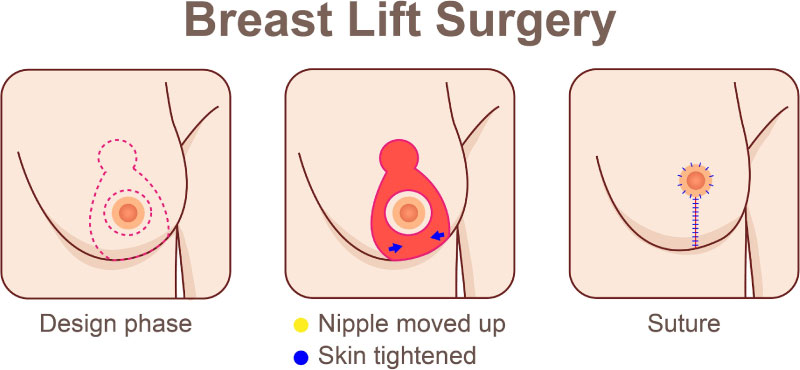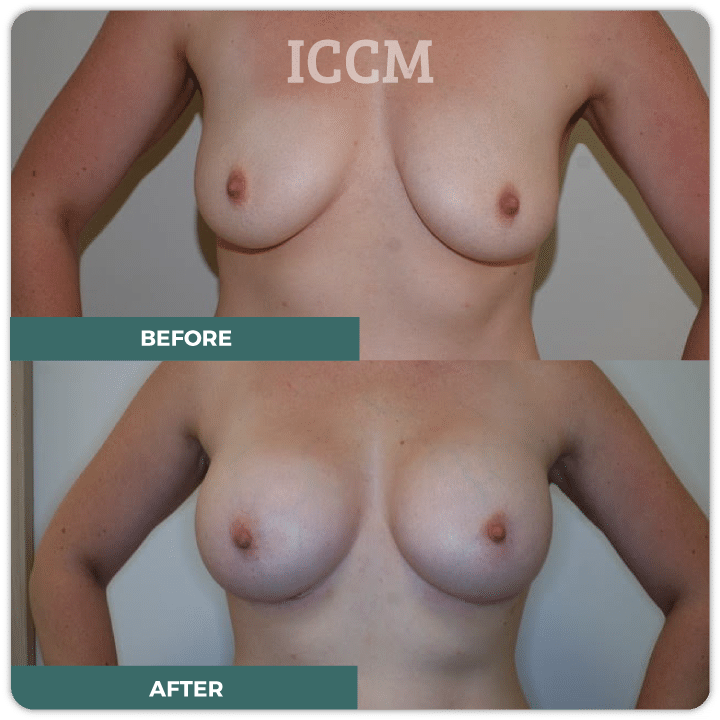Lift Your Self-esteem and Confidence with Breast Lift Surgery in Sydney
A Breast Lift From ICCM Can Balance
Your Figure and Improve Self-Esteem.
A breast lift, also known as mastopexy, creates firmer, more lifted and youthful-looking breasts. Many women find that they begin to experience drooping of their breast tissue with age, which can negatively impact self confidence and satisfaction in their physical appearance.
ICCM Breast Lift Sydney-based surgery addresses the issue of sagging breast tissue by surgically removing excess skin and reshaping the breast to create a firmer, more youthful appearance. If you want to restore the shape of your breasts, contact the friendly team at ICCM to book your consultation.

This illustration demonstrates the goal of the breast lift procedure to restore a more appealing positioning for the breasts.
What Will A Breast Lift Do For Me?
The goal of Breast Lift in Sydney is to enhance the aesthetics of the breast by improving the placement of the breast mound, lifting the underlying tissue and repositioning the nipple.
Understanding the expected outcomes of the breast lift procedure is vital to make sure they align with your body goals. Breast ptosis is the medical term for degeneration of the breast tissue, resulting in a flattened, stretched out or elongated appearance.
Different from breast augmentation, the first thing to note is that standard breast lift surgery does not alter the size of your breasts, nor does it provide a rounder look to the breast's upper section.
Breasts should be fully developed, with enough time post-pregnancy and breastfeeding prior to this procedure. Heavier breasts may droop again over time, and may require a second procedure down the track.
How is the Breast Lift Procedure Done?
During Breast Lift surgery, Sydney patients will have their breasts raised, and the nipples repositioned. The areolas (the dark area surrounding the nipple) may be reduced in size for better proportion. If you’d like to restore lost volume as well, implants may be used to increase breast size and add fullness to the upper pole.
There are many variations to a breast lift procedure.
The techniques our doctors use depend upon your individual features and aesthetic goals. The most common method, which offers the most significant lift, involves three incisions: One around the circumference of the areola, another running vertically from the areola to the breast crease, and a third incision following the natural curve of the crease beneath the breast.
Through these incisions, your doctor will remove the excess breast skin and shape the remaining breast tissue. The nipple and areola, which remains attached to the underlying tissue, are then shifted to a higher position. The areola can also be reduced in size for better proportion. Because the nipples and areolas are left intact, nipple sensation and breastfeeding should not be affected.
Breast Lift Surgery Options
Your individual situation will dictate the amount of skin that is required to be removed for your procedure. This is also determined by your goals, and this will make it evident which type of incision will be required. The options include;
- Lollipop incision
- Anchor incision
- Circular incision
- Crescent Incision
In every case, our doctors work to minimise scarring, ensuring the most pleasing aesthetic possible is achieved. The process most suitable for you will be assessed during your consultation along with an exact cost provided.

Is breast sagging causing issues for you and affecting your self-confidence? The breast lift procedure may be the answer.
Am I A Good Candidate For A Breast Lift Procedure?
A breast lift can be performed at any age; however, it is recommended that women wait until breast development has stopped, a stable weight is achieved, and no future pregnancies are planned. Pregnancy and breast-feeding may have significant and unpredictable effects on the size and shape of your breasts.
A breast lift can be performed on breasts of any size. Women with smaller sagging breasts will likely have longer-lasting results. Larger breasts are more substantial, which makes them more likely to sag again. The following conditions could indicate that breast lift surgery is right for you:
- Have breasts that lack substance or firmness
- Have breasts that are loose and sagging (breasts are flatter and longer)
- Have one breast that falls lower than the other
- Have nipples and areolas that point downward (fall below your breast creases)
- Have areolas stretched out of proportion to your breasts
How much does breast lift in Sydney cost?
Breast lift surgery costs vary depending on a few factors:
- Silicon implants or natural breast tissue
- Size of breasts
- Proportion of lift
All of these can be discussed in detail during your initial consultation with your doctor. Our breast lift procedures start at $10,650 and if you wish to add silicone implants, your bill starts at $13,750.
How can we help?
At ICCM, we stand by our motto of empowering people to be the best versions of themselves. Doctors Tony Prochazka and Ramin Amighain are both highly qualified and board certified. They work together in immaculate fashion to ensure that our quality can be provided to all residents of Sydney and its surrounding communities.
Our doctors and staff regularly attend continuous professional development meetings and seminars to ensure that they are on top of their game and can provide you with only the best and most modern surgical treatments. Book your consultation today and discover more of what we have to offer!
Breast Lift Frequently Asked Questions
It is recommended that you undergo a breast lift when you have no future pregnancy planned as it can cause significant and unpredictable effects to the size and shape of your breasts. This could result in a secondary procedure.
No. Since the nipples remain attached to the tissue during the procedure, the nipples are left intact, and the procedure has no effect on the nipple sensation.
Yes, it can be. Although, if breast sagging has occurred during adolescence, it is advised that you wait until your breasts have finished developing before considering a breast lift.
Your consultation is the perfect time to determine if a breast lift is suitable for your desired outcome. Our skilled and experienced team will assess how much sagging has occurred in your breasts and the amount of nipple lift that will be required. We will also evaluate the quality of your skin and tissue, which will provide a clearer idea of your expected outcome.
As this procedure only requires day surgery, you will not be required to stay overnight. You may experience some discomfort and require antibiotics or pain relief medication following the procedure. Swelling and bruising is also a completely normal reaction to have; however, this will decrease over time.
You can help make your recovery less detrimental by sleeping on your back or side and making sure that you drink plenty of fluids, and eating regular, small meals.
While it will vary for every patient, it will take roughly six weeks for the swelling to subside completely. After this, a further 3-6 months may be required before the final result is revealed.
As this is a surgical procedure, there is an element of risk of infection or bleeding. Bruising and swelling are likely a certainty, but overall, this procedure, which our team has performed many times to positive results, is very safe.
There is also the potential for some asymmetry between the shape of your breasts and a small risk of the ability to breastfeed. All of this will be discussed in more detail during your consultation.
During the consultation, you will be asked about your desired breast shape and size. Your doctor will discuss with you how your nipples and areolas will be repositioned. It would be best if you mentioned anything else about your breasts that you would like to see improved. This will help your cosmetic doctor to understand your expectations and determine whether those expectations can be met.
Depending on your age, or if you have a history of breast cancer in your family, your doctor may also recommend a baseline mammogram before surgery and another mammographic examination some months after surgery. This will help to detect any future changes in your breast tissue. Following a breast lift, you will still be able to perform self-breast examinations. Breast lift surgery will not increase your risk of developing breast cancer.







